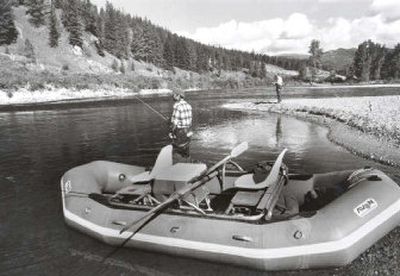Blackfoot flows freely with dam gone

BONNER, Mont. – The Blackfoot River is flowing freely for the first time in more than a century now that crews have removed Bonner Dam, a project tied to the upcoming removal of the larger Milltown Dam nearby on the Clark Fork River.
But the benefit to the trout fishery is still a few years downstream.
Remediation company Envirocon finished removing the 120-year-old Bonner Dam, also called Stimson Dam, on Nov. 25.
The dam east of Missoula was built in 1884 to corral logs floated down the Blackfoot to a sawmill owned by Stimson Lumber Co., and to provide power to the sawmill and nearby communities. The dam had been largely immersed since Milltown Dam was built just after the turn of the century.
“The immediate benefit to fish is pretty minor,” said Pat Saffel, Montana Fish Wildlife and Parks Department regional fisheries manager. “Milltown Dam is nearby and that’s the one that’s impacting the fishery.”
Officials were concerned that if Bonner Dam had remained in place, it would have become unstable after removal of Milltown and the resulting changes in the movement of water.
Some 6.6 million cubic yards of mud laced with metals have accumulated behind Milltown Dam, which stands at the end of the nation’s largest Superfund environmental cleanup site. Plans call for the $100 million Milltown cleanup and removal to start in 2007 and end in late 2009.
Most of the contaminated sediments will be excavated from behind Milltown dam and hauled to a safe site for disposal, but a large amount of sediment will inevitably go downstream as the structure is removed, causing temporary problems for fish, Saffel said.
“We could be recreating the turbid conditions that caused the reduced fish numbers after the high flows of 1996-97,” he said. “But we’ve had to live with those serious runoff impacts every 10 to 12 years on the average since the dams were put in. Hopefully, the year we remove Milltown Dam will be the last time we have that problem.”
Most of the impacts would be in the Clark Fork from the Milltown Dam site downstream to the confluence with the Bitterroot River, he said, noting that the fishery required 4-5 years to recover from the 1996-97 floods.
“But the Bitterroot is a big, cold river and it should dilute any problems in the Clark Fork and minimize the impacts. We expect the fishery to recover quickly from any losses after Milltown is removed and the rebound should be even higher than the current populations.”
(The Associated Press contributed to this story.)